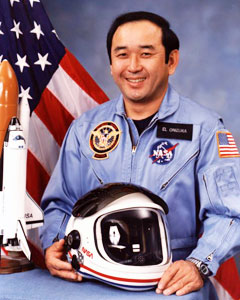
Birthplace: Kealakekua, Kona, Hawaii, June 24, 1946
Challenger Position: Mission Specialist
Education: Graduated from Konawaena High School, Kealakekua, Hawaii, in 1964; received Bachelor and Master of Science degrees in Aerospace Engineering in June and December 1969, respectively, from the University of Colorado
Honors: Presented the Air Force Commendation Medal, Air Force Meritorious Service Medal, Air Force Outstanding Unit Award, Air Force Organizational Excellence Award, and National Defense Service Medal
Ellison Onizuka was one of three mission specialists on Challenger mission STS 51-L. He was born on June 24, 1946 in Kealakekua, Kona, Hawaii to Japanese-American parents. He enjoyed running, hunting, fishing, and indoor/outdoor sports. He graduated from Konawaena High School in 1964 and later received both a Bachelor's and Master's degree in aerospace engineering in 1969 from the University of Colorado at Boulder. He participated in Air Force ROTC which eventually led to a commission. He joined the Unites States Air Force in 1970 where he served as a flight test engineer and test pilot. As an aerospace flight test engineer with the Sacramento Air Logistics Center at McClellan Air Force Base, California, he participated in flight test programs and systems safety engineering for the a number of different aircraft. He attended the USAF Test Pilot School and received formal academic and flying instruction in performance, stability and control, and systems flight testing of aircraft. In July 1975, he was assigned to the Air Force Flight Test Center at Edwards Air Force Base, California, where he served on the USAF Test Pilot School staff. He served as an instructor for the USAF Test Pilot School curriculum courses and logged more than 1,700 hours flying time.
Onizuka was selected by NASA as an astronaut candidate in 1978. He completed a one-year training and evaluation program in 1979. He later worked on orbiter test and checkout teams and launch support crews at the Kennedy Space Center. He also worked on the Shuttle Avionics Integration Laboratory (SAIL) test and revision software team and collaborated on other technical projects. His first space flight was aboard Shuttle mission STS 51-C. This was Discovery's first mission for the Department of Defense. Onizuka was responsible for the activities of the primary payloads, which included the unfolding of the Inertial Upper Stage (IUS) surface. He also became the first Asian-American in space.
Onizuka was selected as a mission specialist for Challenger mission STS 51-L. This was to be his second flight into space. After the accident, he was buried was laid to rest at the National Memorial Cemetery of the Pacific in Honolulu, Hawaii, and was survived by his wife and two daughters. He was posthumously awarded the Congressional Space Medal of Honor. An asteroid and a crater on the Moon were named after him. Onizuka Air Force Station in Sunnyvale, California, Onizuka Village family housing on Hickam Air Force Base and the Astronaut Ellison S. Onizuka Space Center at Kona International Airport in the Kona district of Hawaii were also dedicated to him.




